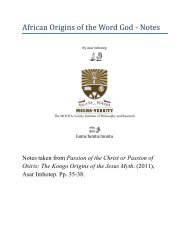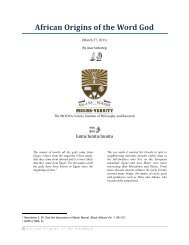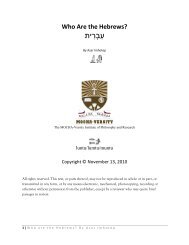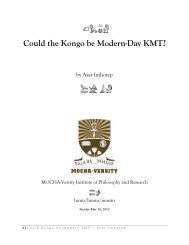reinterpretations of the ankh symbol part 2 - Asar Imhotep
reinterpretations of the ankh symbol part 2 - Asar Imhotep
reinterpretations of the ankh symbol part 2 - Asar Imhotep
You also want an ePaper? Increase the reach of your titles
YUMPU automatically turns print PDFs into web optimized ePapers that Google loves.
20<br />
Lapis Winged Scarab from <strong>the</strong> Global Museum, with King Tut’s coronation name: Neb-Kheper-u-Re<br />
Let’s first examine <strong>the</strong> word xpr in <strong>the</strong> Tshiluba language. The kh- sound is actually a prefix. The ḫ<br />
sound <strong>of</strong>ten becomes a /k/ or /h/ in Niger-Congo languages. The Tshiluba prefix k- can also be ci-.<br />
We first examine <strong>the</strong> ciLuba form <strong>of</strong> <strong>the</strong> word beetle (Scarabaeus sacer).<br />
ḫprr<br />
kapepu, kapepwela, kapepula, kapulupulu,<br />
kaholoholo, kampulu, cipepu, cipepwela,<br />
cipepula, ciholoholo, cipulupulu; cimpulu 14<br />
We note that <strong>the</strong> image <strong>of</strong> ḫpr is <strong>of</strong> him raising <strong>the</strong> sun (Ra) in <strong>the</strong> eastern horizon. There are a few<br />
terms in ciLuba that are <strong>of</strong> importance for us here. To raise, in ciLuba, is shu-la. The root <strong>of</strong> <strong>the</strong> word<br />
ḫpr has <strong>the</strong> meaning <strong>of</strong> “wind” or to “blow.” In ciLuba “blown” is pupa, peeps, pepula, pupwila. In<br />
Luba Cipepu or Cipepewela can also be rendered ku-ku-Pepa or pepula “blow, being carried by <strong>the</strong><br />
wind.” We should note that Cipepu-la means “strong wind,” “Breath bearer <strong>of</strong> Ra.” The key words<br />
are Pa “to give, to sponsor, to award; blow Pe/Pa “wind” (also cipepa, cipepela) and Pela-Ditem<br />
“friction or making fire by rubbing with stone or wooden flint.”<br />
This pe/pa, pepu, etc, root is an ancient Niger-Congo root meaning wind or to blow. 15<br />
PWN PHET “blow,” PHUPH “wind, blow”, PHUP “pigeon, dove” (flap wings), I Yorùbá afefe<br />
“wind,” III Lefana o-fe-fe “wind,” V Temne a-fef “wind,” VI Mende fefe “wind, breeze,”<br />
Mangbetu mbimbato “wind,” Bantu pepo “wind”, Swahili upepo “wind,” Bantu (Meeussen)<br />
peep “blow.” Fula fufede “blow” (forge). 16<br />
14 Bilolo (2008: 201).<br />
15 See Westermann’s Index B (1927 : 310 f) for reconstructed PWS and Bantu roots; *pap “wind.”<br />
16 See GJK Capbell-Dunn (2006: 88). Who Were <strong>the</strong> Minoans: An African Answer. Author House Publishing.<br />
Bloomington, IN.






